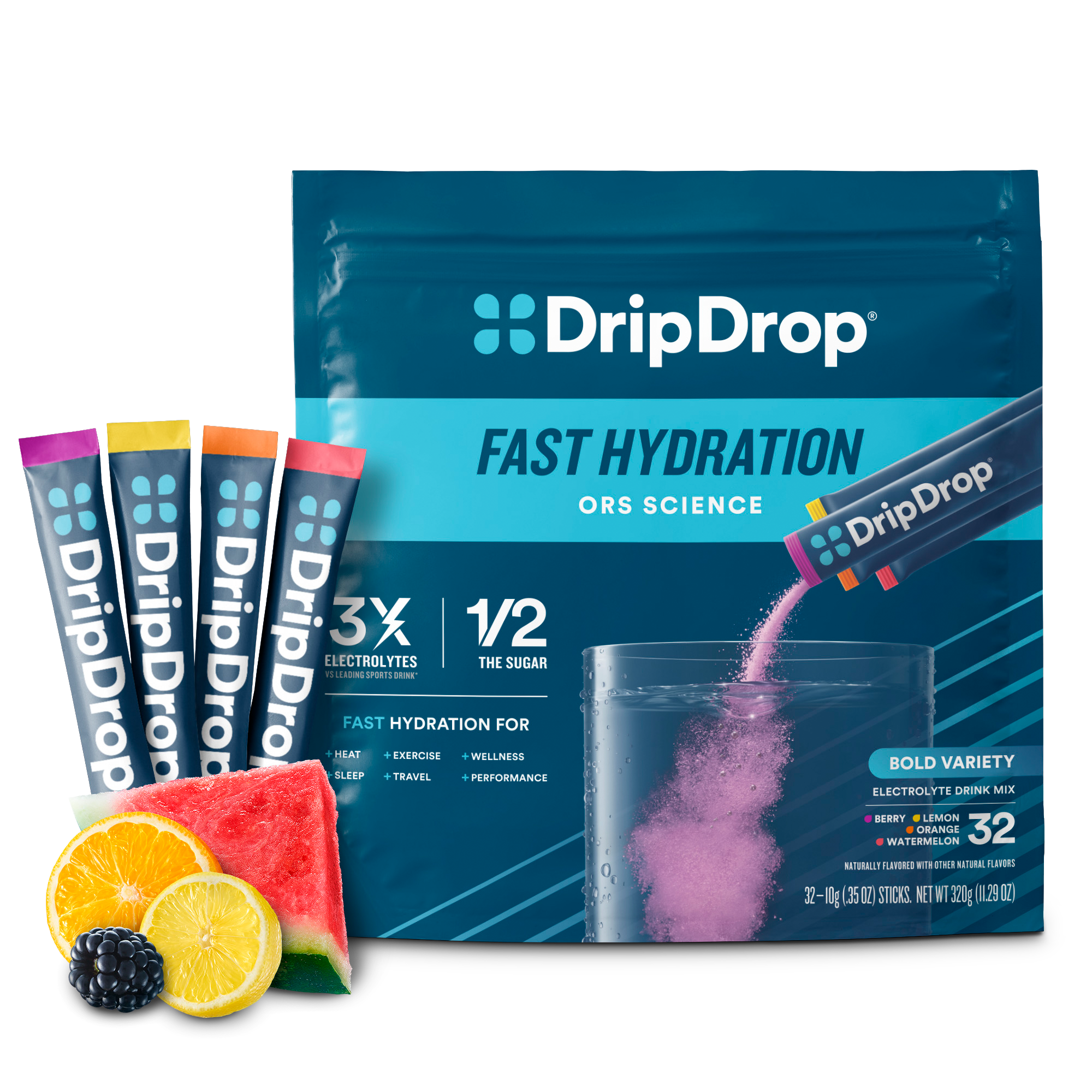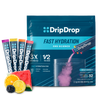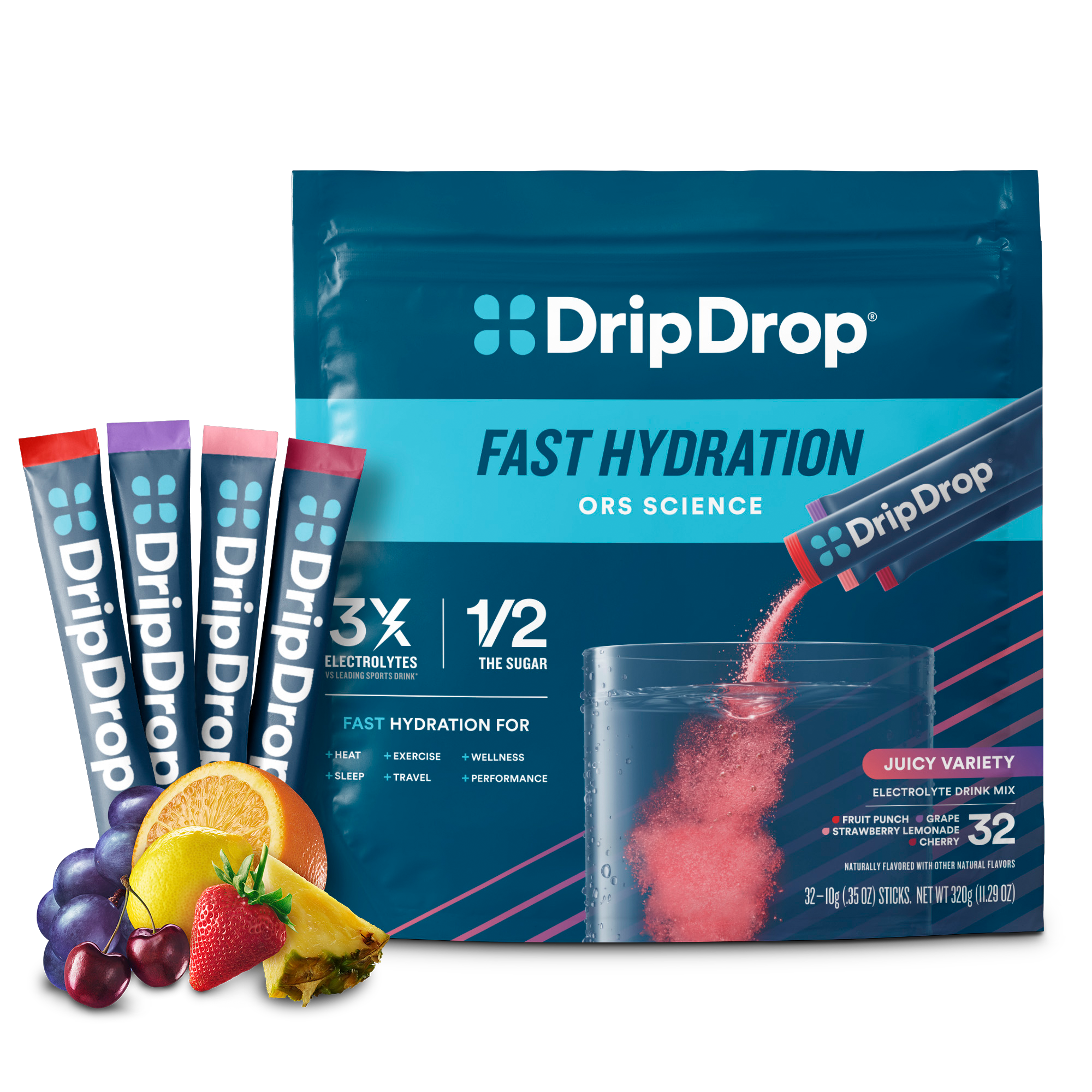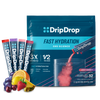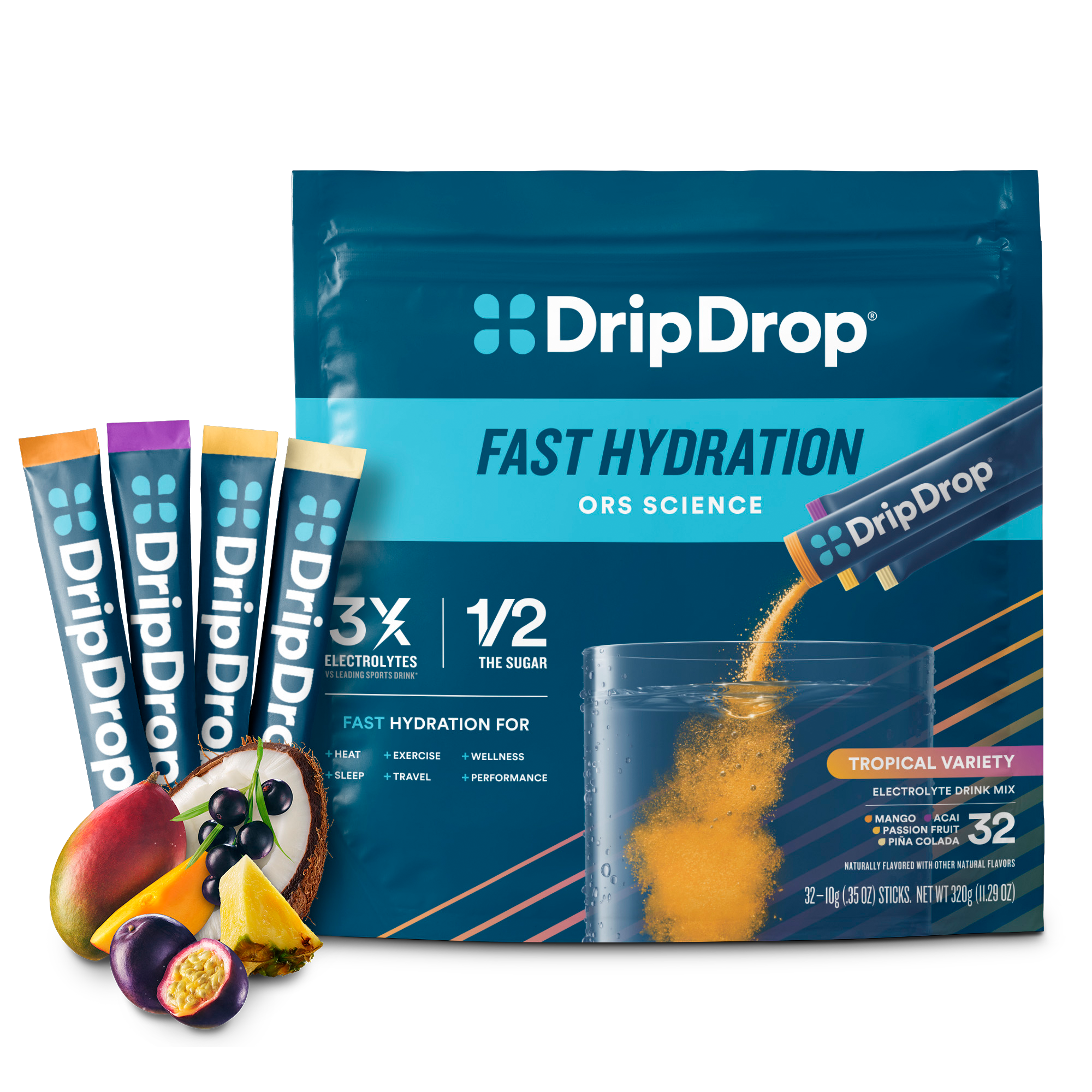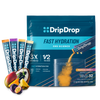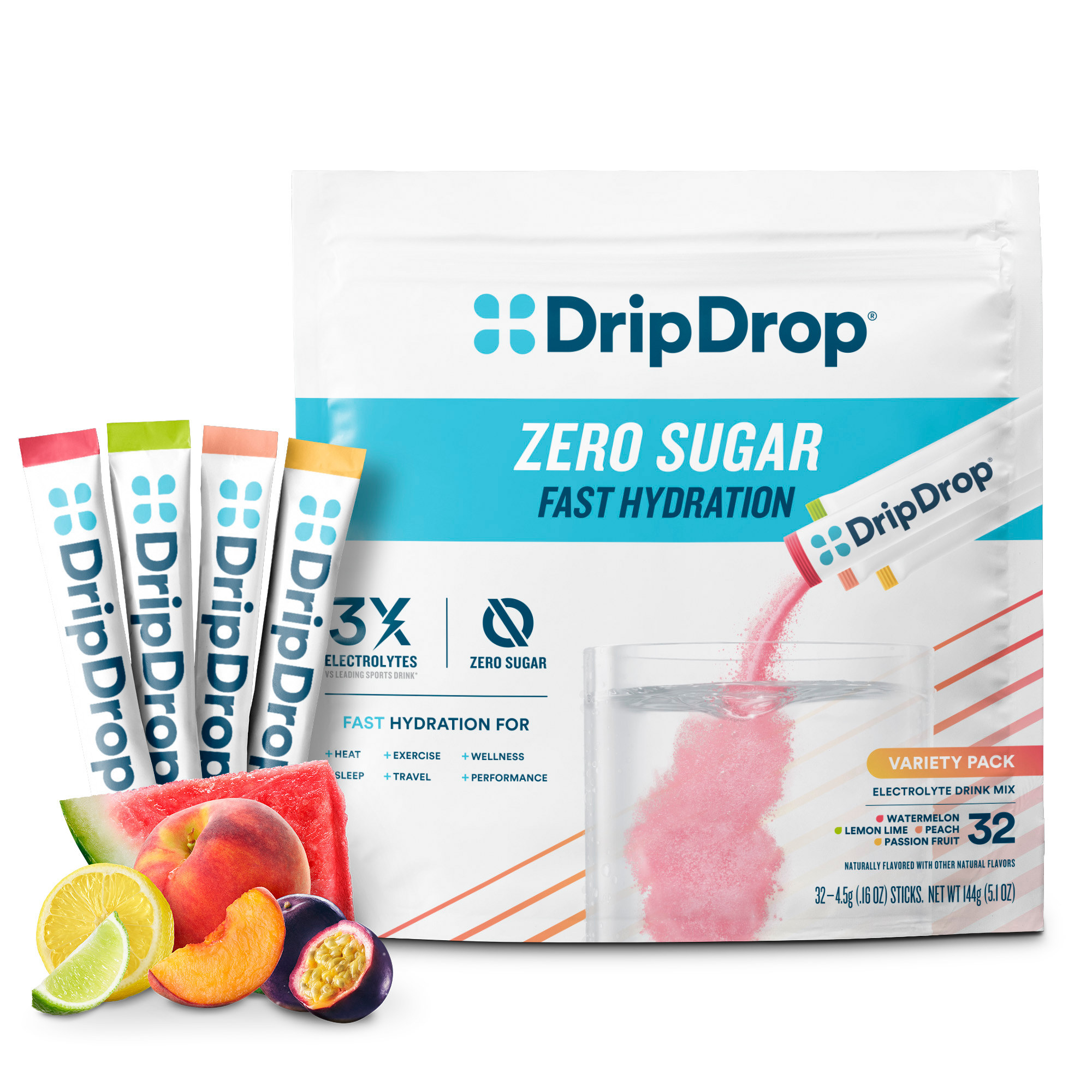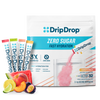You may not realize it, but you lose fluids and electrolytes as you breathe, sweat, and use the restroom. The problem is when you can’t replace fluids and electrolytes as fast as they leave your body.
If you’re regularly experiencing signs of dehydration, developing a hydration routine should be your top priority. But you have to understand that staying hydrated and relieving dehydration requires more than drinking water.
Oral rehydration salts are often recommended along with oral rehydration solutions like DripDrop. However, oral rehydration salts aren’t always an appealing option due to their poor taste. DripDrop is an effective, great tasting solution for mild to moderate dehydration.
In this article, we’re putting the spotlight on oral rehydration salts, its recommended dosage, and how it works.
What Are Oral Rehydration Salts?
An oral rehydration salts solution is a mixture of glucose, sodium chloride, sodium citrate, and potassium chloride, approved and recommended by the World Health Organization (WHO) and the United Nations International Children's Emergency Fund (UNICEF) to treat dehydration worldwide. It was first used in 1969.
In 1984, trisodium citrate dihydrate replaced sodium hydrogen carbonate (sodium bicarbonate) in the original ORS mixture to improve its stability in hot, humid environments.
For the next 20 years, WHO and UNICEF recommended the same formulation —90 mEq/l of sodium with a total osmolarity of 311 mOsm/l — to manage dehydration resulting from diarrheal disease regardless of what causes the diarrhea or how old you are.
Osmolarity refers to the number of particles suspended in a solution.The more particles are suspended in a solution (i.e., the higher the osmolarity), the slower the absorption of water from your small intestines to your bloodstream for dehydration relief.
In 2001, WHO and UNICEF updated their ORT formula to ensure effectiveness based on new, emerging research from various clinical trials. The new formula contains the following:
-
Anhydrous glucose: 13.5 grams / liter
-
Sodium chloride: 2.6 grams / liter
-
Trisodium citrate dihydrate: 2.9 grams / liter
-
Potassium chloride: 1.5 grams / liter
Three years later, WHO and UNICEF recommended the addition of zinc to ORS treatment of all childhood diarrhea. In 2019, WHO announced the inclusion of co-packaged oral rehydration salts (ORS) and zinc sulfate in its Model List of Essential Medicines and Model List of Essential Medicines for Children.
In most countries, commercial ORS packets are available in pharmacies, health centers, and groceries. In developing nations like Bangladesh, homemade oral rehydration salts solutions are used if commercial ORS isn't available — one liter of water, six teaspoons of sugar, and a half teaspoon of salt.
It's worth noting that ORS can be used interchangeably to describe oral rehydration salts and oral rehydration solutions.
Quick disclaimer: We don’t recommend home-made oral rehydration salts. An ORS also cannot treat or address diarrheal disease. Consult with your healthcare practitioner for help.
Why Dehydration Is Dangerous in Children and How DripDrop Can Help
Young children have a greater risk for dehydration because their bodies are smaller. This means fewer reserves of electrolytes and fluids that get depleted if they're sick with diarrhea. They should be monitored closely for the following signs of dehydration:
-
Sunken soft spot on top of the child's head
-
Sunken eyes
-
Crying without tears
-
Dry or sticky mouth and mucus membranes
-
Diapers that are lighter than usual or children who are peeing less often
-
Irritability
-
Less activity than normal
The problem with traditional formulations of oral rehydration salts is they can taste dreadful — especially for children.
Upon seeing children spit out the life-saving formulas, Dr. Edurado Dolhun knew something had to change. He created DripDrop to solve the ORS taste problem without compromising efficacy.
DripDrop is an ORS (oral rehydration solution) used for oral rehydration therapy (ORT). It contains the medically relevant sodium electrolyte levels and lower glucose content required in an ORS, in a low osmolarity formula that facilitates fast absorption. Plus, it tastes great! Kids will love all its flavors like Fruit Punch, Concord Grape, and Strawberry Lemonade.
Guidelines for Oral Rehydration Salts
The CDC recommends giving an oral rehydration solution "immediately to dehydrated patients who can sit up and drink." Meanwhile, vomiting patients should have "small, frequent sips of ORS." If a patient can't drink or sip ORS, ORS via a nasogastric tube is advised.
How Much ORS Should You Use?
The recommended dose for hydration is usually written on the ORS packet or sachet. You can also check out the dosage of oral rehydration salts solution recommended by WHO to remedy mild to moderate dehydration in this quick guide by Medecins Sans Frontieres.
According to the guide, you should continue giving oral rehydration salts as long as signs of dehydration such as diarrhea persist. However, if the patient's eyelids become puffy during the treatment, stop oral rehydration salts and give plain water instead. Resume once the puffiness is gone.
Another critical detail is to only mix oral rehydration salts with clean water. Also, do not mix oral rehydration salts with other liquids like sports drinks, fruit juices, or milk. Finally, do not add extra sugar or salt, as it’ll change the ratio of electrolytes and glucose, which may impact its effectiveness.
Often, the taste of oral rehydration salts isn’t appealing, especially for children. For children with mild to moderate dehydration, DripDrop is a powerful alternative. It is safe for pediatric cases and it comes in delicious flavors that kids love.
You can give DripDrop with a spoon, a 20 cc syringe or through a sippy cup for young children. Older children should sip the solution slowly (waiting 10-20 seconds between sips). If your child is vomiting, make sure they drink slowly, in small sips.
Speak with your physician before using DripDrop for children less than one year of age.
Why DripDrop Is the Top Choice to Crush Dehydration
Even with its new, improved formula, many oral rehydration salts remain unpalatable. Dehydrated children, for example, may refuse to drink these solutions when they have a strong salty taste.
If patients don't drink ORS, it can't work in managing dehydration. A remedy is only as effective as a patient's willingness to take it. It's for this reason that DripDrop's formula is unique — you get a medically viable ORS that also tastes great.
Aside from its superior taste to oral rehydration salts, DripDrop is also a medical-grade formula and scientifically proven to enable fast, effective fluid absorption and retention.
When you're dehydrated, you need to activate the sodium-glucose cotransport system. The right sodium-glucose ratio activates the cotransport system in the small intestine. This system draws molecules of glucose and sodium, as well as attracting water, into your bloodstream. Furthermore, sodium helps the body retain water more efficiently, encouraging you to drink more. This is how your body gets dehydration relief fast.
How do you get this system to work? You need a precise ratio of sodium electrolytes and glucose in your oral rehydration solution. DripDrop contains the medically relevant sodium electrolyte levels and glucose content required to defeat dehydration.
But it's not as simple as combining sodium and glucose in the right way. You also need low osmolarity to increase fluid absorption. DripDrop's formula uniquely balances all of these critical ORS components to keep osmolarity low, at just 220mosm/L. It's even lower than the WHO ORS formula (245msom/L).
Plus, it tastes amazing and comes in various flavors you can enjoy hot or cold.
DripDrop: Manage Dehydration With Great Taste
Oral rehydration salts can help replace water, electrolytes, and other minerals that the body loses during dehydration. However, higher sodium electrolyte content and lower glucose (sugar) content can sometimes make them unpalatable.
As a result, children and adults who need to hydrate may not reach for oral rehydration salts. Luckily, there’s another choice: an oral rehydration solution like DripDrop's formula.
It contains a precise balance of electrolytes to crush dehydration. Plus, it can be used as an alternative to intravenous fluid therapy for managing mild to moderate dehydration. Most of all, it tastes fantastic!
DripDrop also supplies vitamins like zinc, potassium, and magnesium, which are essential to support your overall health.
Get started with our most popular multi-flavor pouch for dehydration relief fast. Or, learn more about how you can save up to 25% on every purchase when you subscribe.



